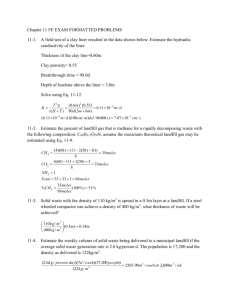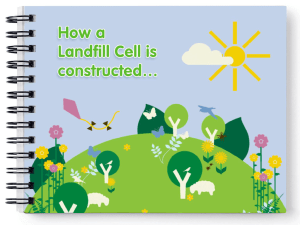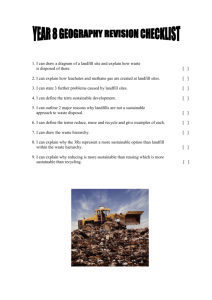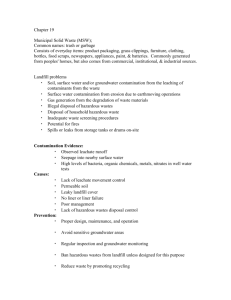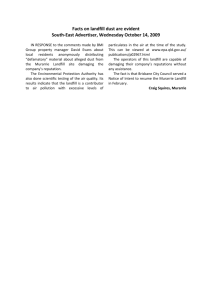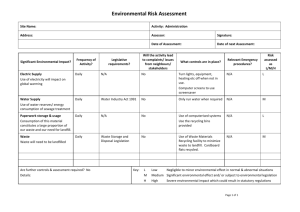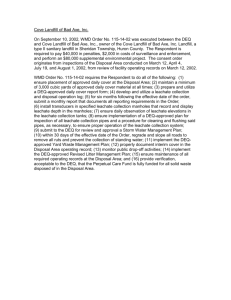SOUTHERN WASTE SOLUTIONS CATEGORY C CELL LANDFILL
advertisement
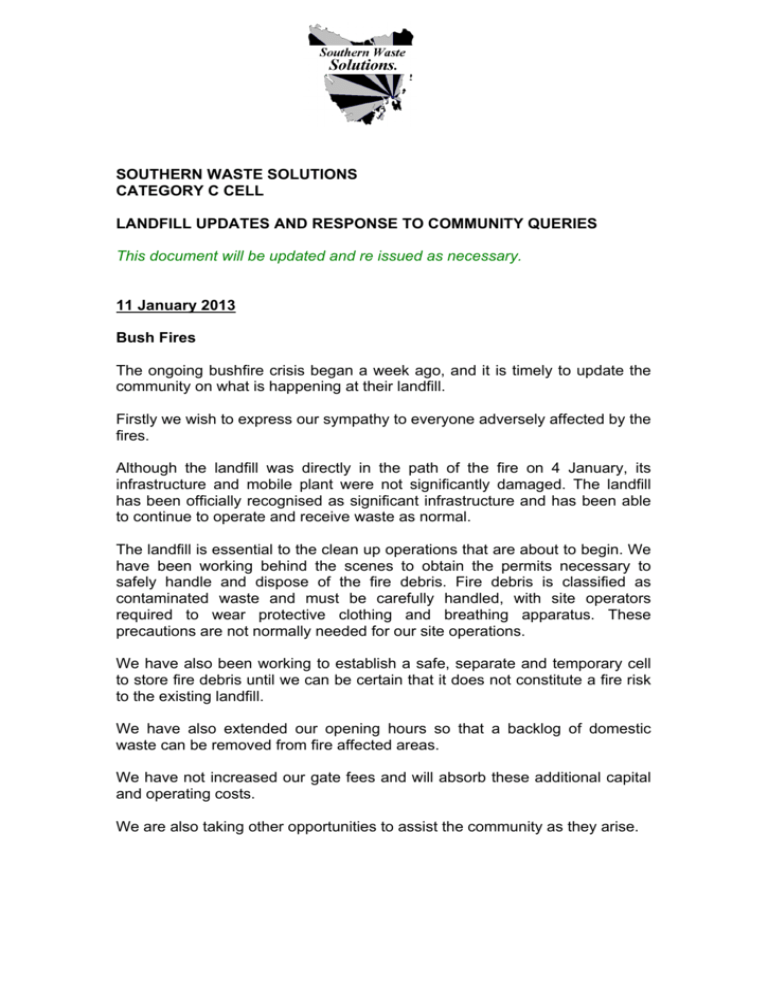
SOUTHERN WASTE SOLUTIONS CATEGORY C CELL LANDFILL UPDATES AND RESPONSE TO COMMUNITY QUERIES This document will be updated and re issued as necessary. 11 January 2013 Bush Fires The ongoing bushfire crisis began a week ago, and it is timely to update the community on what is happening at their landfill. Firstly we wish to express our sympathy to everyone adversely affected by the fires. Although the landfill was directly in the path of the fire on 4 January, its infrastructure and mobile plant were not significantly damaged. The landfill has been officially recognised as significant infrastructure and has been able to continue to operate and receive waste as normal. The landfill is essential to the clean up operations that are about to begin. We have been working behind the scenes to obtain the permits necessary to safely handle and dispose of the fire debris. Fire debris is classified as contaminated waste and must be carefully handled, with site operators required to wear protective clothing and breathing apparatus. These precautions are not normally needed for our site operations. We have also been working to establish a safe, separate and temporary cell to store fire debris until we can be certain that it does not constitute a fire risk to the existing landfill. We have also extended our opening hours so that a backlog of domestic waste can be removed from fire affected areas. We have not increased our gate fees and will absorb these additional capital and operating costs. We are also taking other opportunities to assist the community as they arise. 21 November 2012 Protesters Continue to Spread Propaganda The Carlton River group continue to push their propaganda by publishing the following on their blog: As this group has been given the facts about this on numerous occasions, this post demonstrates what Southern Waste Solutions has been saying for some time now - they are not interested in the facts surrounding the category C cell. An entry in this document dated 24 September provides part of our evidence in this regard. The reference copied above is a reference to the overall site, and to the current B landfill site. The existing B landfill will eventually be approximately 200m from the unnamed and usually dry tributary, and 200m from the river itself. The B landfill is between the river and the C cell, and between the unnamed tributary and the C cell. The actual distances are approximately 1750m and 750m respectively. It should be noted that the recommended buffer distance between a permanent watercourse and a C cell is 100m. Controlled Waste This same scaremongering site has also included information contained on the EPA web site without putting it in context. That information and its context follow: http://epa.tas.gov.au/regulation/controlled-waste Controlled Waste Controlled waste is the most hazardous category of waste and includes those wastes that exhibit toxicity, chemical or biological reactivity, environmental persistence, or the ability to bio-accumulate or enter the food chain. These wastes need to be carefully managed and are closely regulated because of their potential to adversely impact human health and the environment. The Copping C cell will accept contaminated soil. Contaminated soil is classified as level 1 (suitable for an unlined landfill that may be referred to as a tip or a dump), level 2 (most likely controlled waste and currently deposited in the existing Copping B cells subject to certain conditions), level 3 (controlled waste that will be deposited in the Copping C cell subject to certain conditions) and level 4 (controlled waste that is not able to be disposed of without treatment to a lower level). The definition of controlled waste includes waste up to level 4. This latter will not come to the C cell. Nuclear waste is not mentioned because it is not regulated by the EPA and will not be deposited in any landfill. 18 November 2012 Open Day Unfortunately SWS has had to cancel the open day planned for 24 November following public comments made by some members of a group protesting against our development. These comments raised security concerns. We decided to err on the side of caution in the best interests of safety of the public. We will make alternative arrangements for site visits for those with a genuine interest in our facility. Soil Remediation Facility Southern Waste Solutions recently issued a media release and held a press conference to, among other initiatives, announce plans for a soil remediation facility at its Copping landfill. This facility will be designed to help address concerns expressed by the community, as it will treat waste to a lower level and reduce quantities going to the C cell. It will not alter traffic quantities on the highway to the site, as the waste would be destined for Copping in any event. The facility will include a concrete base, concrete walls and a roof. It will be removed at the end of its approximate 10 year estimated life span. Similar to the C cell, different soil types will be kept separate within the facility until treatment has been completed and the soil disposed of in the appropriate landfill cell. 11 November 2012 Wilkie Today the member for Denison issued a letter to the Prime Minister of Australia on behalf of the group protesting against the C cell development. Unfortunately there are a number of factual errors in the letter as follows: Para 1: "toxic waste dump". The waste is not toxic and we have a scientific paper dealing with this fact. It is available on our web site at http://swstas.com.au. Also it is a properly engineered cell (as are our B cells). It is not a dump. Para 2: “A great many Tasmanians". We received responses from about 22 people during our extended consultation period. There were about 28 bits of paper stuck in our box after our community meeting as well. Fewer than 1800 people (if we include the petition) does not constitute "a great many". Para 2: "absence of a state-wide hazardous waste policy". The first state-wide report that we are aware of was dated 1991 and it concluded that the state needs at least one, but preferably 3, secure landfill cells. The next report in 1992 supported this finding. Another state-wide report prepared by Sustainable Infrastructure Australia in 2008 said that Tasmania's lack of a C cell may result in significant costs to Tasmanian businesses and may impede the state's economic expansion. Para 2: "containment linings unreliable". This is contrary to the science and also ignores the facts that we have 4 liners; and that a clay liner recently excavated in Italy was still impermeable after approximately 2000 years. Para 3: "social licence". The existing landfill obtained a social licence and has been happily operating for more than 10 years. This is not a greenfield site. The public was not interested when SWS did its own promotion of the C cell development prior to and during the statutory process. Para 3: "thousands of signatories to a petition". Last we heard it was 1700 and we are not sure whether this is a valid total after eliminating potential duplications and false names. In any event 1700 is not thousands. There is also the issue of the recent Sorell election where, of 4 candidates standing for Mayor, only one candidate supported the C cell and that candidate received in excess of 60% of the vote. It seems that Mr Wilkie may be riding rough shod over the community rather than the reverse, particularly given the fact that any reduction in grant monies will potentially be a reduction in funds being directed back to the surrounding community. Para 4: "conflict of interest" displays a complete lack of knowledge of the planning process, including the involvement of the independent regulator assessing the science etc of the project and giving it a big tick; and the role of a council as a planning authority and the issues that can and cannot be taken in to account when considering a Development Application. It also ignores the fact that the only other option was a project of regional/state significance, an option rejected by the Authority for the very reason that it would deprive the community of a say about the development. Para 5: "toxic waste". Refer above. The science and all political parties support this development as being clean and green, as well as in the best interests of Tasmanian business and industry. Remember that Tasmania is the only state without such a facility, and that there is a similar facility operating successfully within the suburbs of Melbourne (less than 500m from a densely populated area v 2.4 km; recommended distance 300m). 19 October 2012 Community Reference Group SWS is in the process of developing Terms of Reference and an Application for Membership of a Community Reference Group (CRG). We envisage this group to include a maximum of 20 members drawn from an appropriate mix of local businesses, industries and residents. It will be an advisory rather than decision making body. It will meet in the local area, most likely in the evenings, approximately 6 to 8 times per year. The group will decide the timing, frequency and location of meetings. Agendas and minutes will be available on our web site. SWS will call for applications for membership of the CRG within the next few weeks (NOT in the mercury’s Public Notices!). Other waste that will not be accepted (refer entry dated 12 September) The list dated 12 September is not meant to be all-inclusive, and no allinclusive list is practical. However, herbicides have been specifically queried; and we confirm that they also belong on the list of unacceptable items. We would like to point out that soil that is contaminated with such materials may be delivered to the site provided that testing by an independent laboratory shows that the soil tests below the levels specified for 32 different potential contaminants, and subject to EPA approval. Sorell Council earthquake regulations (mercury letters to the editor 13 October 2012) SWS wrote to the mercury to advise the facts regarding the above but the letter was not published. Sorell Council has no such regulations, as the municipality does not have an earthquake problem. In the past it has requested work be done to investigate land stability. Landslip activity occurs in the Bream Creek area due to past land clearing activities. It is not related to seismic activity. 6 October 2012 Fault line The regularly mentioned geological fault that has a potential vertical displacement up to 300m was not the result of seismic activity but of the intrusion of dolerite in the Jurassic period. It is extremely stable. Seismic activity has been dealt with below (12 September). 4 October 2012 Ecosystem and endangered species The site is not a greenfield proposition. The entire footprint of the existing landfill was logged in approximately 1990 and a landfill has occupied the site since 2001. The exact site of the C cell was a quarry prior to the property’s acquisition by its current owners. A botanical and zoological assessment was included in the Development Proposal and Environmental Management Plan for the existing landfill. It was concluded that “[t]here are no zoological reasons why this project should not proceed." The Policy and Conservation Branch advised the EPA in relation to the category C cell development. Their advice (included in the EPA’s Environmental Assessment Report) was that: “A number of listed fauna species may occur in the area. These include chaostola skipper (Antipoda chaostola) listed as endangered under the TSPA, the Tasmanian devil (Sarcophilus harrisii) and the swift parrot (Lathamus discolour) listed as endangered under the TSPA and the Environment Protection and Biodiversity Conservation Act 1999 (EPBCA). Given that the development is within a highly disturbed environment, it is unlikely to impact these threatened species.” Combined with the facts that the cell will not discharge leachate to groundwater or to the Carlton River or its tributaries; the waste will be soil and not attractive to fauna, and that waste will be covered every day; it is considered that there is no risk to fauna. Emergency management plans The cell is designed to prevent catastrophic failure. Our permit (at G7) requires us to have a detailed site specific plan approved by the EPA before the cell is commissioned. This plan must be prepared in consultation with the EPA, the State Emergency Service and the Tasmanian Fire Service 1 October 2012 Submissions received SWS has received submissions from two organisations (the Tasmanian Conservation Trust and the Carlton River Catchment & Southern Beaches Conservation group) and 47 individuals. This number includes queries submitted at our public information session on 12 September. The majority of submissions were responded to within 24 hours. People providing street or post office box addresses will be responded to within the next few weeks, as we plan to provide them with material in addition to answers to their personal questions. Those providing email addresses obviously have access to the internet and to our web site so are able to access the full range of information themselves. Returning a mix of condensed leachate into the cell – possibility of a chemical reaction The C cell leachate will indeed be a mix of chemicals, some of which may react with each other. Provided the resulting leachate is collected and treated and not released to the environment, this is not an environmental concern. As described in the DPEMP (page 50), the collected leachate will initially be subjected to pH dosing to precipitate some of the dissolved solids such as metals; the remaining leachate will then go to passive and active evaporation to precipitate out the remaining dissolved solids. The resultant sludges will be returned to the C cell. All leachate products will therefore be retained within the C cell. Possibility of drying out of bottom 1000mm clay liner Clay does not dry out by water draining from it under gravity. The very small pore spaces in clay means that it holds moisture against the force of gravity. Clay can dry out only when there is an evaporative surface. The membranes covering the clay will mean that there will not be an evaporative surface and the underlying clay will therefore retain its moisture indefinitely. 29 September 2012 Climate change The potential for increased rainfall due to climate change has no significant bearing on the design or operation of the C cell. The projected increase in rainfall runoff in the Carlton River catchment due to climate change over the next 30 years is less than 7% (Bennett et al (December 2010) Climate Futures for Tasmania Water and Catchments Technical Report). The projected life of the C cell is in the order of 10 years. Given the conservative sizing of the leachate ponds and the active evaporation contingency, a 7% or less increase in leachate volumes is not material to the operation of the C cell. At the end of the 10 year period the cell will be capped. The cell cap will be formed into a convex shape to shed water. As described in the Cell Design Report, the cell cap will include an impermeable LDPE membrane. This will be underlain by compacted clay, which will form an additional water barrier, and overlain by a gravel drainage layer, and then top soil, which will be planted with stabilising vegetation. The vegetation will protect the top soil. Rain that percolates through the top soil will be stopped from percolating further by the LDPE membrane and backup clay barrier, and will therefore drain off the cap through the gravel drainage layer. This water will have had no contact with waste. The impermeable cap will mean that no additional rain will enter the waste and the waste will gradually dry until no further leachate is generated. Failure of some other similar facilities The design of the C-cell is based on the EPA’s Landfill Sustainability Guide 2004. This guideline reflects international best practice in landfill design, which is based on the performance of landfills around the world. The Copping C cell exceeds this standard. We are not aware of any modern landfills designed, constructed and operated in accordance with contemporary best practice standards that have had significant leachate leaks. Older landfills designed, constructed and/or operated to lesser standards have leaked and that is why we have contemporary best practice standards like the Landfill Sustainability Guidelines and that is why SWS has designed our C cell to meet (indeed, exceed) those guidelines. 24 September 2012, updated 28 September Consultation The statutory obligation for advertising this project lies with the planning authority not with SWS; community representations were directed to the EPA not SWS. It is not true to say that only minimal consultation was undertaken in relation to this project. SWS sends agendas to adjoining landowners, and a C cell has been on these agendas for several years. Adjoining landowners were written to with offers of personal briefings a week before this project was advertised by the Sorell Council. SWS printed and distributed several hundred leaflets in the Sorell municipality. Nobody responded. SWS also briefed politicians from all parties about this project at the same time as adjoining landowners were written to and leaflets distributed. Politicians’ communication with their colleagues and their communities did not result in any responses or queries. The Hobart mercury published the public notice relating to this project, and also received a media release from the EPA. It did not show any interest in the project. Distance to the Carlton River The facility is approximately 750m from the unnamed tributary of the Carlton River, and 1,750m from the Carlton River. The regularly quoted 200m refers to the distance of the existing landfill footprint (it will not reach this boundary for some time) from the tributary. 19 September 2012 Potential gas emissions and explosions All municipal landfills generate methane, including the existing landfill cells at Copping. Southern Waste Solutions (SWS) has recently installed a landfill gas recovery system for its existing cells. Methane gas from these cells is currently being flared, and in future will be collected to generate power. As described in the C cell DPEMP, this power will be available to assist with the evaporation of leachate from the C cell if required. The C cell itself will not generate methane in sufficient quantities to contribute to this power source, and there is no credible potential for methane explosions. Other potential minor quantities of gases generated within the C cell will depend on the particular chemical characteristics of wastes accepted in to the cell, but gas generation is unlikely to be significant because liquid wastes will not be accepted. The solids and sludges that will be accepted will be much more stable than liquids. Wastes will also be separately placed within the C cell and will not be mixed; in particular potentially reactive wastes will be kept separated. The EPA will assess the potential for reactions and gas generation when considering approval for the each waste type proposed to go to the C cell. Wastes that could generate quantities of gas sufficient to potentially harm people or the environment would simply not be accepted at the C cell. 18 September 2012 Potential concentration of waste arising from evaporation At our community information session a member of the local community raised a concern that evaporation of leachate followed by returning the resulting sludge to the facility could concentrate the waste. Some rainfall is likely to enter the cell, and this will result in leachate. Leachate is evaporated and the resulting sludge returned to the facility. The system is a closed loop, with evaporating water being the only substance to leave the facility. The process can be likened to a salt-water aquarium, where evaporation of water (no salts etc) happens naturally. Pure water needs to be replaced to maintain the composition of the water in the tank. Pure water is removed and then replaced, keeping the contents in balance. In the same way the addition and removal of rainwater, combined with transfer of sludge to and from the leachate pond (still within the closed loop facility) in the leachate process, will not affect the system’s overall balance. The facility’s contents are neither diluted nor concentrated. Gate fees This issue was addressed on 14 September, but under the heading of funding. Gate fees will be set to recover the full costs of constructing, financing, operating, close out, ongoing monitoring and after care. The total of these amounts will be divided by the facility’s capacity to arrive at a cost per tonne over the weighbridge. The final design has not yet been commissioned, and so the actual cost is not yet known. Therefore no gate fee can be provided at this stage. 14 September 2012 Consideration of other sites Numerous sites have been evaluated over approximately 20 years for suitability as a landfill in general. If a site is not suitable for a landfill in general it will certainly not be suitable for a C cell. At least 15 sites in the south of the state were investigated before Copping was developed. Sources of waste It is not certain where waste will come from at this stage. Until industry has somewhere to dispose of its level 3 waste it will be reluctant to publicise the fact that it has any. A major source of waste for the facility is expected to be the Hobart rail yard redevelopment. In the past some businesses in the aquaculture industry used copper based antifoul on their nets. Hosing these nets on the shore resulted in level 3 soil. Other sources of level 3 waste are expected to include grit from sandblasting bridges, ship/yacht hulls etc. Funding The development will be fully self funded. The total cost of the project (including close out costs, ongoing monitoring and after care) will form the basis of a gate fee per tonne of waste received at the facility. So those businesses and industries producing the waste will pay for the facility. 13 September 2012 National Pollutant Inventory (NPI) The NPI provides the community, industry and government with free information about substance emissions in Australia. It has emission estimates for 93 toxic substances and the source and location of these emissions. The Copping landfill provides input to this database. The data is model based, and depends on the number of tonnes landfilled. It is not based on monitoring or measurement. The true measure of the site’s environmental performance is the independent testing and monitoring that is reported to the EPA and adjoining land owners. Some comparisons from the 2011 NPI report follow: Facility Benzene Acetone Kg Kg Port Latta Landfill Copping Landfill McRobies Gully Waste Management Centre Launceston Waste Centre Sorell Municipality: solid fuel burning (domestic) Motor vehicles Backyard incinerators Recreational boating Liquid fuel burning (domestic) 46 20 99 20 42 44 Arsenic & Compounds Kg 0.0219 0.0073 - 116 52 0.1166 5,400 7,400 0.2200 4,700 270 190 - 1,000 210 - 0.024 The Copping landfill is a minor contributor to these statistics, particularly in comparison to households in the area. Carlton River Catchment Current Status Natural Resource Management South’s Tasman Catchment Summary 2008 states that the “Carlton River is a hotspot for poor water quality due to land use, waste water (septic systems) and stormwater contamination.” “Point source pollution from septic tank failure or other domestic waste management systems (due to poor soil capability and aging infrastructure) is a widespread problem across the catchment, particularly in the White Beach and Connellys Marsh area. Innovative solutions to trial new technologies and provide incentives to landowners are needed.” It is estimated that there are approximately 3,600,000 litres of human excrement and grey wastewater leaching in to the soil profile and ground water. This is a current, proven, serious threat to the Carlton River catchment area. Already, at certain times of the year beaches at Dodges Ferry (e.g. Red Ochre) are closed with signs warning of E coli counts. The Copping facility will not pollute the catchment. The main risk to the catchment already exists, and already results in regular adverse environmental effects. 12 September 2012 Nuclear and/or radioactive waste Such waste is regulated by the Department of Health and Human Services (DHHS). There are no known sources of such waste in Tasmania other than that held by DHHS including in hospital cancer wards, or in school physics laboratories. None will be deposited in the Copping facility. No nuclear and/or radioactive waste will be deposited in the facility. Other waste that will not be accepted The facility will not accept many materials including: • • • • • • • • • • Nuclear/and or radioactive waste Liquids – all waste must be spadeable Acids Alkalis Inorganic and/or organic chemicals Liquid paints (paint flakes may be accepted subject to independent testing and approval by the Environment Protection Authority (EPA)) Solvents Pesticides Oil Any waste testing above the level 3 threshold for 32 separate contaminants No nuclear/radioactive waste, liquids or waste testing higher than level 3 will be accepted, and all waste must first be independently tested and then approved by the EPA. Seismic activity The multiple cell liners have been proven to withstand earthquakes far larger than the one that severely damaged Christchurch. The liners can withstand earthquakes of a magnitude 10,000 times greater than the largest ever recorded in Tasmania. Available data (from 1 January 1958) indicates that there have been 28 seismic events within a 25km radius of Copping. There is a swarm of 18 such events within a one-month period during 1987 indicating that there were actually no more than 11 underlying events. This swarm averaged 1.1 on the Richter Scale, and the maximum was 1.2. They were all very shallow, with an average depth of 1.5km and a maximum depth (two) of 4km. The greatest magnitude recorded within a 25km radius was 2.7. The definition of a seismic event of this magnitude is “minor, generally not felt.” The Copping area is considered geologically stable. The site is geologically stable; nevertheless the facility is designed to cope with earthquakes 10,000 times greater than ever recorded in Tasmania. Longevity of liners The designing engineers advise that the underlying clay liner has been designed to "last for many thousands of years". During that time it would be expected that technology will have changed and other viable methods of dealing with the waste (reprocessing etc) will be available. In Italy there is a clay liner that is still impermeable after approximately 2,000 years. Multiple man made liners combined with a compacted native clay liner will provide protection for thousands of years. Leachate Regular independent monitoring shows that groundwater leaving the current site is cleaner than that entering the site. The new facility will be even more secure. Because the facility will not accept liquids, and because it will be kept covered, it is not expected to generate large quantities of leachate. Any leachate that is generated will be drained in to a leachate pond for evaporation. Resulting sludge will be placed back into the facility. If leachate does not evaporate quickly enough (for example during winter), it will be evaporated using heat or electricity derived from the capture of methane from the current landfill operation. The nature of the leachate means that any contaminants (mostly metals) will not evaporate. What if a liner is punctured, ruptures or fails? The design includes a witness sump that still has a 2mm impermeable HDPE liner (several centuries of service life) and then a 1000mm compacted native clay liner (at least 2000 years service life) underneath it. This gives a considerable amount of time to deal with any problem in the highly unlikely event that one occurs. Identifying the location of any failure will be facilitated by the detailed recording of the location of various types of wastes. The composition of the leachate will narrow down the source. Potential action will include removing the waste and placing it in temporary storage (of a higher standard then its current containment) while the problem is repaired. It should be noted that above the witness sump, between it and the waste, there is: 5mm drainage net 6mm geosynthetic clay liner 2mm impermeable HDPE membrane 5mm cushion geotextile 300mm washed stone aggregate 5mm filter geotextile waste Potential reactions between different waste types Waste will be segregated within the cell. Its location will be recorded using GPS technology. This will allow waste to be located and extracted for reprocessing as technology changes. Organic farming status A Department of Primary Industries, Parks, Water and Environment spokesperson and experienced accredited organic farm inspector has advised that, given the low risk of contamination, the proposed facility is unlikely to have a negative effect on organic certification. However it is up to the producer to either prove that any risk is negligible, or if a risk exists how it will be negated. SWS is prepared to assist adjoining neighbours with this process if it proves to be necessary. Water table Bores have not been drilled in the proposed footprint of the facility. The development proposal (page 27) states that “groundwater under the base of the C-cell will be deeper than 2 to 3 m below the base, perhaps substantially so. Nevertheless, it is possible that the groundwater under the Ccell might approach closer than the 5 m minimum separation between it and waste specified by the Landfill Sustainability Guide for Category C cells.” The inclusion of a groundwater relief system in the conceptual design is a precautionary measure. It is likely that the clearance between waste and groundwater will exceed the recommended 5m separation without any need for a groundwater relief system. Hepatitis A Hepatitis A has been raised as a concern. This requires faecal matter. No faecal contaminated matter will be accepted by the facility. The existing landfill has received medical waste for a number of years. It will continue to do so. Such waste includes items such as sharps and bandages. It does not include body parts, pharmaceuticals, bulk blood etc. It is treated and tested before being delivered to the existing landfill as general waste i.e. it is classified as the same level as domestic waste. The EPA and DHHS have both approved this practice.
